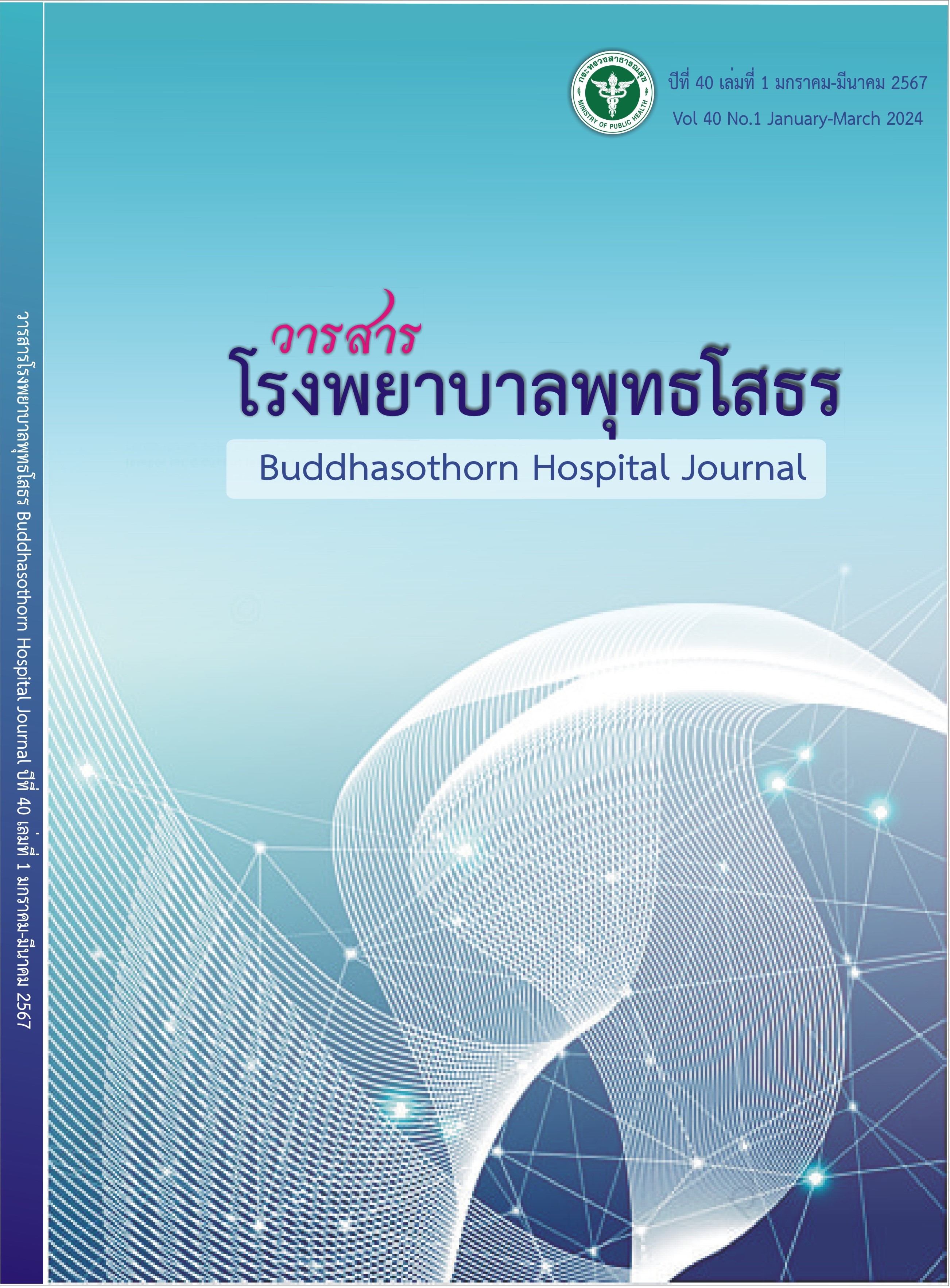การศึกษาเชิงพรรณนาของโรคนิ่วในไตในจังหวัดสระแก้ว
Main Article Content
บทคัดย่อ
ที่มาและความสำคัญ : โรคนิ่วในไตเป็นปัญหาสาธารณสุขที่พบมากทั่วโลก เป็นปัญหาที่ส่งผลต่อคุณภาพชีวิต มีหลายปัจจัยที่ส่งผลทำให้เกิดนิ่วในไต และยังมีแนวโน้มเพิ่มขึ้นในปัจจุบัน อย่างไรก็ตามผู้ป่วยโรคนิ่วไตส่วนใหญ่ยังไม่มีอาการแสดงที่ชัดเจน ทำให้การรวบรวมข้อมูลความชุกของผู้ป่วยโรคนิ่วในไตของประเทศไทยทำได้ต่ำกว่าความเป็นจริง
วัตถุประสงค์ : เพื่อศึกษาหาความชุกของโรคนิ่วในไตในฐานข้อมูลของโรงพยาบาลสมเด็จพระยุพราชสระแก้วและเพื่อศึกษาลักษณะประชากรที่เป็นโรคนิ่วในไต
วิธีการศึกษา : ศึกษาข้อมูลผู้ป่วยที่ได้รับการวินิจฉัยโรคนิ่วในไตในโรงพยาบาลสมเด็จพระยุพราชสระแก้ว ตั้งแต่ 1 กรกฎาคม 2565 – 30 มิถุนายน 2566 จำนวน 341 ราย โดยเก็บข้อมูลทั่วไป ข้อมูลทางคลินิกและการรักษาที่ได้รับ
ผลการศึกษา : ผู้ป่วยโรคนิ่วในไตจำนวน 341 ราย อัตราส่วนชายต่อหญิง 1.3:1 อายุเฉลี่ย 57.6 ปี มีผู้ป่วยประกอบอาชีพเกษตรกร 92ราย(ร้อยละ 27.0) มีโรคประจำตัว 174 ราย(ร้อยละ 51.0) โรคที่พบบ่อยคือ โรคความดันโลหิตสูง โรคไตเสื่อมเรื้อรัง และโรคเบาหวาน ผู้ป่วยมีประวัติครอบครัวเป็นโรคนิ่วในไต 32 ราย(ร้อยละ 9.4) พฤติกรรมลดความเสี่ยงการเกิดโรคพบการดื่มน้ำมากกว่า 2.5ลิตร 45 ราย(ร้อยละ 13.2) และออกกำลังกาย 41 ราย(ร้อยละ 12.0) อาการที่พบมากที่สุดคือ อาการปวดเอวหรือปวดหลัง 128 ราย(ร้อยละ 37.6) มีการทำงานของไตผิดปกติ 84 ราย(ร้อยละ 24.6) มีผลปัสสาวะผิดปกติ 160 ราย(ร้อยละ 46.9) ได้รับการรักษาโดยการปรับพฤติกรรมเสี่ยง 341 ราย(ร้อยละ 100) ร่วมกับการกินยา 215 ราย(ร้อยละ 63.0) และการผ่าตัด 67 ราย(ร้อยละ 19.6)
สรุป : ความชุกของโรคนิ่วในไต 1.2 ต่อประชากร 1,000 คน ผู้ป่วยส่วนมากเป็นผู้ชาย อายุเฉลี่ย 57.6 ปี ส่วนมากเป็นเกษตรกร มีโรคประจำตัวร่วม มาพบแพทย์ด้วยอาการปวดเอวปวดหลัง ผลปัสสาวะเกือบกึ่งหนึ่งผิดปกติ และได้รับการรักษาโดยการปรับเปลี่ยนพฤติกรรมเสี่ยงร่วมกับการกินยาหรือผ่าตัด
Article Details

This work is licensed under a Creative Commons Attribution-NonCommercial-NoDerivatives 4.0 International License.
References
Tosukhowong P, Yachantha C, Sasivongsbhakdi T, Boonla C, Tungsanga K.//Nephrolithiasis: pathophysiology, therapeutic approach and health promotion.//ใน//Chulalongkorn Medical Journal.//Bangkok.// 2006 (Vol.50).
Yanagawa M, Kawamura J, Onishi T, et al. Incidence of urolithiasis in northeast Thailand. Int J Urol. 1997;4(6):537-540. doi:10.1111/j.1442-2042.1997.tb00304.x
Liangchawengwong S. The Comparative Study of Kidney Stone Formation-Risk Factors and Warning Signs and Predictive Risk Factors Relating Kidney Stones between Patients with Kidney Stones and the Comparison Group. JPNC [Internet]. 2020 Dec. 29 [cited 2023 Dec.27];31(2):138–157. Available from:https://he01.tci-thaijo.org/index.php/pnc/article/view/246231
Pinsuwan C, Tangjaroen S, Thatarporn R. Urinary stone disease in Kalasin hospital. Srinagarind Med J 2001.[Internet].2001 [cited 2023 Dec 27]; Available from:https://www.thaiscience.info/Journals/Article/SRMJ/10463393.pdf
Santanapipatkul K, Jantakun W, Tanthanuch M. Urinary tract stone analysis in Loei province. Insight Urol [Internet]. 2019 Nov. 7 [cited 2023 Dec. 27];40(2):09-18. Available from: https://he02.tci-thaijo.org/index.php/TJU/article/view/217869
Obligado SH, Goldfarb DS. The association of nephrolithiasis with hypertension and obesity: a review. Am J Hypertens. 2008;21(3):257-264. doi:10.1038/ajh.2007.62
Losito A, Nunzi EG, Covarelli C, Nunzi E, Ferrara G. Increased acid excretion in kidney stone formers with essential hypertension. Nephrol Dial Transplant.2009;24(1):137-141. doi:10.1093/ndt/gfn468
Stamatelou K, Goldfarb DS. Epidemiology of Kidney Stones. Healthcare (Basel). 2023;11(3):424.Published 2023 Feb 2. doi:10.3390/healthcare11030424
Suarez Arbelaez MC, Nackeeran S, Shah K, et al. Association between body mass index, metabolic syndrome and common urologic conditions: a cross-sectional study using a large multi-institutional database from the United States. Ann Med. 2023;55(1):2197293.doi:10.1080/07853890.2023.2197293
Geraghty RM, Davis NF, Tzelves L, et al. Best Practice in Interventional Management of Urolithiasis: An Update from the European Association of Urology Guidelines Panel for Urolithiasis 2022. Eur Urol Focus. 2023;9(1):199-208. doi:10.1016/j.euf.2022.06.014
Bhojani N, Bjazevic J, Wallace B, et al. UPDATE - Canadian Urological Association guideline: Evaluation and medical management of kidney stones. Can Urol Assoc J. 2022;16(6):175-188. doi:10.5489/cuaj.7872
Taguchi K, Cho SY, Ng AC, et al. The Urological Association of Asia clinical guideline for urinary stone disease. Int J Urol. 2019;26(7):688-709. doi:10.1111/iju.13957
Cupisti A. Update on nephrolithiasis: beyond symptomatic urinary tract obstruction. J Nephrol. 2011;24 Suppl 18:S25-S29. doi:10.5301/JN.2011.7766
Chang CW, Ke HL, Lee JI, et al. Metabolic Syndrome Increases the Risk of Kidney Stone Disease: A Cross-Sectional and Longitudinal Cohort Study. J Pers Med. 2021;11(11):1154. Published 2021 Nov 6. doi:10.3390/jpm11111154
Lee MR, Ke HL, Huang JC, Huang SP, Geng JH. Obesity-related indices and its association with kidney stone disease: a cross-sectional and longitudinal cohort study. Urolithiasis. 2022;50(1):55-63. doi:10.1007/s00240-021-01288-w
Sasaki Y, Kohjimoto Y, Iba A, Matsumura N, Hara I. Weight loss intervention reduces the risk of kidney stone formation in a rat model of metabolic syndrome. Int J Urol. 2015;22(4):404-409. doi:10.1111/iju.12691
